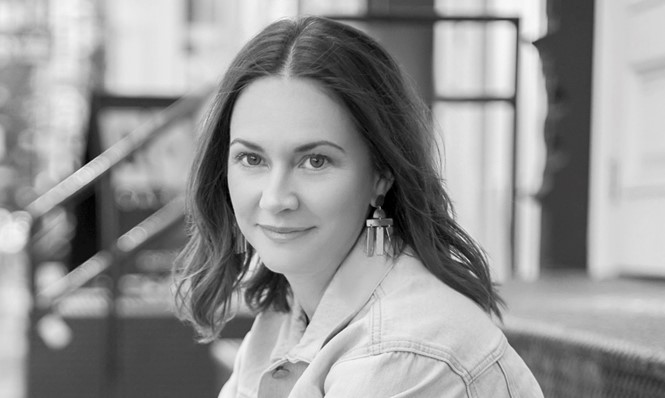Invisible stories

Meg Beckum, executive creative director at global design consultancy Elmwood, discusses the pivotal role of healthcare design in connecting minority narratives.
Imagine a healthcare system where everything from the way your illness is diagnosed right through to how seriously your pain is taken is distorted via a prism of racial and cultural bias. Despite the best efforts of legions of frontline professionals – it’s also a living reality across some of the world's biggest, most medically advanced healthcare systems today.
Take the UK, where white people are more than twice as likely to receive help for mental health issues compared to black people. Meanwhile in the US, pregnancy-related mortality rates among black, American Indian and Alaska Native women are up to three times higher than their white counterparts, in a framework riddled with systemic inequalities and made significantly worse by Covid.
Traditionally, the role of design in this complex, intransient picture hasn’t been given much space; a major oversight when you consider how central it is to the everyday, lived experience of healthcare. If design is intelligence made visible (according to brand consultant Alina Wheeler), in a clinical setting, it can also bring invisible narratives into the light as a powerful conduit to accessibility and inclusion.
From this perspective, holistic design – seen not just as a visual lexicon, but a means of communication and connection across every touchpoint in a patient journey – is one part of the solution to providing more access and pathways to quality healthcare for underserved minorities. And it deserves more attention than it gets.
The pathway to representation
The deficit of meaningful, nuanced design makes engaging and empowering experiences in healthcare an exception rather than a rule. Where they do exist, they’re more likely to appear in the domain of highly polished, privately owned wellbeing apps that lie far beyond reach of society’s most marginalised groups.
While a long history of discrimination means some people from minority backgrounds – for example, US Hispanics – are more likely to mistrust medical providers, other groups, such as Britain’s Roma population, tend to fall outside the parameters of healthcare altogether.
Just framing these problems from a design point of view, therefore, is the start of a new, more people-centric approach that can be transformational. When you begin a conversation around issues such as healthcare accessibility, or outcome barriers, within the vernacular of a specific community, you begin to galvanise that community’s ability to better voice its needs.
Elmwood recently partnered with Indigenous PACT, a mission-driven collaborative that works on achieving health equity for American Indians and Alaska Natives. For the impact of design to improve healthcare deliveries, we had to consider the unique needs of every tribal community within PACT’s framework; and also act on them collectively.
The Pima Indians of Arizona, for instance, have the highest rates of diabetes in the world, linked to a vast list of alarming complications such as cardiovascular disease and cognitive decline. As Jan Vasquez, a Mescalero Apache community research director points out, it’s a disparity best tackled by leaning into indigenous solutions and ideas; of “bringing back the culture in itself”.
Overcoming barriers
Just as a disease prevention programme might be scoped to a particular community’s environment or resources – for example, the use of indigenous talking circles as an activity to drive diabetes awareness – so a process of co-design with specific groups can help break down barriers in healthcare communication.
In a 2021 study published in the International Journal for Equity in Health, Australian researchers described how they co-designed consumer engagement strategies to improve cancer services amid a wide variety of minority ethnic and linguistic groups, building trust via a series of peer-led community workshops. It’s this level of collaboration we need in healthcare communication, to ensure little-heard voices are heard and included with culture-specific design practices.
Ideally, patients will engage proactively and early with healthcare systems, in a manner that would significantly improve outcomes for common diseases such as cancer or respiratory conditions. Instead, healthcare services in both Britain and the US are often so convoluted and clinical in their outlook – especially for groups that are already vulnerable to prejudice, or who are socially or economically disadvantaged – that patients delay or go without critical medical care.
The beauty of design is that it can shift the dynamics of a particular healthcare experience, making it simpler, more personalised, more accessible and more empathetic in the way that it relates to the outside world. And this, in turn, will have an inviting, inclusive effect, breaking down community-specific barriers around language, lack of trust, literacy and more – in support of preventative healthcare.
The end-to-end healthcare experience
You can have all the beautiful fonts and photography that you like; but the real art of co-design and a tailored design experience is more intrinsic. More than a pretty look, it shapes how a particular minority group or local community might feel towards a given medical provider or healthcare brand.
At its best, healthcare design should facilitate multiple ‘moments of truth’ in which a person feels connected to a brand at every single point of interaction. Take the design of digital journeys. A report from the NHS Race and Health Observatory earlier this year found that healthcare apps have the potential to empower patients and reduce inequalities; but only if they are implemented carefully, with trusted, personalised content and a focus on community, rather than individual users. Again, consultation workshops with representatives from minority communities in a particular area can help achieve this goal.
Equally, design is crucial to all touchpoints in a physical environment, too. If you’re having an abortion at a Planned Parenthood clinic in America, research shows that the stigma around terminations means you’ll already be more likely to feel vulnerable or anxious going in (especially if you have to run the potential gauntlet of protesters outside). But there are so many thoughtful touches that design can enable to make the entire experience more soothing and welcoming to clients, at every moment; from the kind of greeting someone receives on arrival to the particular colour of a recovery room.
An undervalued tool
There’s little doubt that healthcare providers both in the US and the NHS are failing many patients from ethnic minority backgrounds right now, with a series of intrinsic problems that range from the medical profession’s inability to recognise skin cancer on darker skin to patient experiences of pain that are somehow minimised or rendered invisible due to a history of both explicit and implicit racism.
Design alone cannot solve this entrenched, multifaceted problem. But it does have an (often unsung) part to play in repairing the disconnect between many healthcare providers and the communities that they serve; as well as fixing specific communication gaps.
A personalised digital design project could make the difference in encouraging people of Black Caribbean and Black African heritage to donate blood in the fight against sickle cell disease, for example; or to challenge stigmas around depression among elderly Asian Americans.
Whatever the aim, design’s ability to help address some of the underlying causes of health inequity with culturally-tailored experiences cannot be underestimated. It’s a tool that’s both impactful and increasingly important at a time when our multi-ethnic populations are growing older, bigger and more diverse; with a wider strata of demands than at any time in history.












